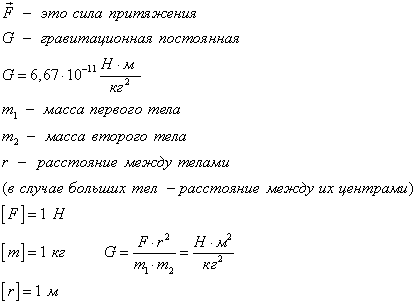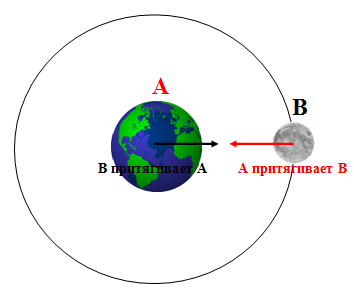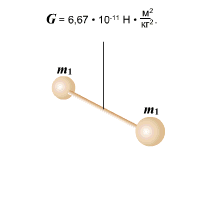Law of gravity
The phenomenon of gravity is the law of universal gravitation. Two bodies act on each other with a force that is inversely proportional to the square of the distance between them and directly proportional to the product of their masses.
Mathematically, we can express this great law by the formula


Gravity acts over vast distances in the universe. But Newton argued that all objects are mutually attracted. Is it true that any two objects attract each other? Just imagine, it is known that the Earth attracts you sitting on a chair. But have you ever thought about the fact that a computer and a mouse attract each other? Or a pencil and pen on the table? In this case, we substitute the mass of the pen, the mass of the pencil into the formula, divide by the square of the distance between them, taking into account the gravitational constant, we obtain the force of their mutual attraction. But, it will come out so small (due to the small masses of the pen and pencil) that we do not feel its presence. Another thing is when it comes to the Earth and a chair, or the Sun and the Earth. The masses are significant, which means that we can already evaluate the effect of force.
Let's think about free fall acceleration. This is the operation of the law of attraction. Under the action of a force, the body changes speed the slower, the greater the mass. As a result, all bodies fall to the Earth with the same acceleration.
What is the cause of this invisible unique power? To date, the existence of a gravitational field is known and proven. You can learn more about the nature of the gravitational field in the additional material on the topic.
Think about what gravity is. Where is it from? What does it represent? After all, it cannot be that the planet looks at the Sun, sees how far it is removed, calculates the inverse square of the distance in accordance with this law?
Direction of gravity
There are two bodies, let's say body A and B. Body A attracts body B. The force with which body A acts begins on body B and is directed towards body A. That is, it "takes" body B and pulls it towards itself. Body B "does" the same thing with body A.

Every body is attracted by the Earth. The earth "takes" the body and pulls it towards its center. Therefore, this force will always be directed vertically downwards, and it is applied from the center of gravity of the body, it is called gravity.
The main thing to remember
1) Law and formula;
2) Direction of gravity
Some methods of geological exploration, tide prediction and, more recently, the calculation of the movement of artificial satellites and interplanetary stations. Early calculation of the position of the planets.
Can we set up such an experiment ourselves, and not guess whether planets, objects are attracted?
Such a direct experience made Cavendish (Henry Cavendish (1731-1810) - English physicist and chemist) using the device shown in the figure. The idea was to hang a rod with two balls on a very thin quartz thread and then bring two large lead balls to the side of them. The attraction of the balls will twist the thread slightly - slightly, because the forces of attraction between ordinary objects are very weak. With the help of such an instrument, Cavendish was able to directly measure the force, distance and magnitude of both masses and, thus, determine gravitational constant G.

The unique discovery of the gravitational constant G, which characterizes the gravitational field in space, made it possible to determine the mass of the Earth, the Sun and other celestial bodies. Therefore, Cavendish called his experience "weighing the Earth."
Interestingly, the various laws of physics have some common features. Let's turn to the laws of electricity (Coulomb force). Electric forces are also inversely proportional to the square of the distance, but already between the charges, and the thought involuntarily arises that this pattern has a deep meaning. Until now, no one has been able to present gravity and electricity as two different manifestations of the same essence.
The force here also varies inversely with the square of the distance, but the difference in the magnitude of electric forces and gravitational forces is striking. In trying to establish the common nature of gravity and electricity, we find such a superiority of electric forces over gravitational forces that it is difficult to believe that both have the same source. How can you say that one is stronger than the other? After all, it all depends on what is the mass and what is the charge. Arguing about how strong gravity acts, you have no right to say: "Let's take a mass of such and such a size," because you choose it yourself. But if we take what Nature herself offers us (her own numbers and measures, which have nothing to do with our inches, years, our measures), then we can compare. We will take an elementary charged particle, such as, for example, an electron. Two elementary particles, two electrons, due to the electric charge repel each other with a force inversely proportional to the square of the distance between them, and due to gravity they are attracted to each other again with a force inversely proportional to the square of the distance.
Question: What is the ratio of gravitational force to electrical force? Gravitation is related to electrical repulsion as one is to a number with 42 zeros. This is deeply puzzling. Where could such a huge number come from?
People are looking for this huge factor in other natural phenomena. They go through all sorts of big numbers, and if you want a big number, why not take, say, the ratio of the diameter of the universe to the diameter of a proton - surprisingly, this is also a number with 42 zeros. And they say: maybe this coefficient is equal to the ratio of the diameter of the proton to the diameter of the universe? This is an interesting thought, but as the universe gradually expands, the constant of gravity must also change. Although this hypothesis has not yet been refuted, we do not have any evidence in its favor. On the contrary, some evidence suggests that the constant of gravity did not change in this way. This huge number remains a mystery to this day.
Einstein had to modify the laws of gravity in accordance with the principles of relativity. The first of these principles says that the distance x cannot be overcome instantly, while according to Newton's theory, forces act instantly. Einstein had to change Newton's laws. These changes, refinements are very small. One of them is this: since light has energy, energy is equivalent to mass, and all masses attract, light also attracts and, therefore, passing by the Sun, must be deflected. This is how it actually happens. The force of gravity is also slightly modified in Einstein's theory. But this very slight change in the law of gravity is just enough to explain some of the apparent irregularities in Mercury's motion.
Physical phenomena in the microcosm are subject to other laws than phenomena in the world of large scales. The question arises: how does gravity manifest itself in a world of small scales? The quantum theory of gravity will answer it. But there is no quantum theory of gravity yet. People have not yet been very successful in creating a theory of gravity that is fully consistent with quantum mechanical principles and with the uncertainty principle.


